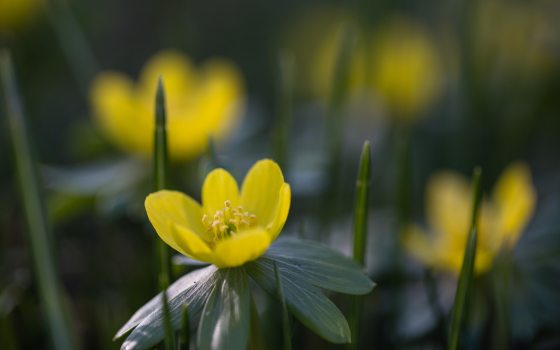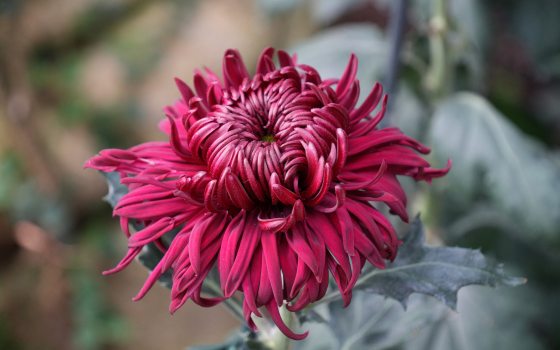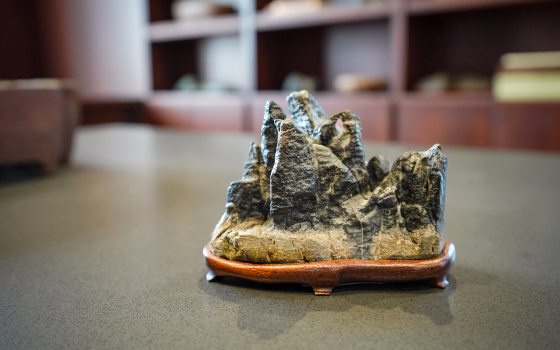The beauty and abundance of flowers—both in gardens and in nature—is the hallmark of the spring season. Although their beauty is obvious and appreciated by all, these highly anticipated floral displays are the result of complex, interacting factors. Plant genetics, ecosystem dynamics, pollinator availability, current and historic weather and moisture patterns, climate change, anthropogenic effects, and more have influenced the evolution of spring flowering plants to respond to the seasons, fill specific ecological niches, form relationships with other members of the ecosystem, and determine how we use them in gardens. The resulting variety of unique adaptations and botanical curiosities of some of our favorite spring flowers provides further connection between people and plants and helps enrich these flowers’ beauty.
Bulbs: Charting the Cadence of Spring
The emergence and flowering of spring bulbs, such as winter-aconite (Eranthis hyemalis), snowdrops (Galanthus), daffodils (Narcissus), tulips (Tulipa), and crocus (Crocus), is one of the most anticipated events of the season. The cadence of bright-colored flowers begins with the whites and yellows of snowdrops and winter-aconites, continues through the yellows of Narcissus, and the brilliant hues of crocus, corydalis, and tulips.

Found in Peirce’s Woods and along Oak and Conifer Knoll, winter-aconite is among the earliest flowering spring bulbs. Photo by Carol DeGuiseppi.
While people enjoy these refreshing colors, it’s important to remember that these colors aren’t really meant for us, but rather to attract the early emerging pollinators of the season. The fact that spring flowers begin with whites and yellows, and then lead to an expanded palette, leads some to hypothesize that specific colors, such as white and yellow, are particularly attractive to early emerging pollinators and have evolved to meet this need.
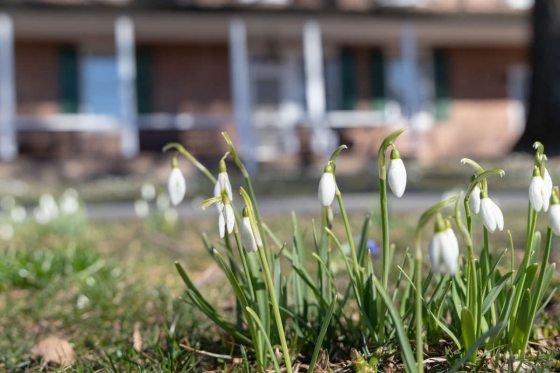
Galanthus perch outside of the Peirce-du Pont House. Photo by Bob Doerr.
However, pollinators don’t perceive color the same way we do, and the scientific community has debated the evolution of certain flower colors in response to pollinator availability. While the debate rages on, we (and pollinators!) will continue to enjoy the flowers no matter what scientific outcome is reached.
Magnolias: Ancient Beauty
The precocious flowering magnolias, such as Magnolia denudata, M. stellata, M. × loebneri, and M. × soulangeana, and their relatives and hybrids, comprise some of the most recognizable and revered of spring flowering trees. The large flowers, generally born at the ends of leafless branches, are remarkable for their size and uniqueness, but belie an ancient and interesting pollination phenomenon. Although many types of pollinators can be found in the flowers, magnolias are an ancient lineage of plants that were present before many of the current pollinators (bees, flies, etc.) existed and were originally meant to attract various types of beetles as pollinators. As an added attraction, the flowers of some species exhibit a trait called “floral thermogenicity”— a phenomenon in which the flowers generate their own heat to attract, and retain, the pollination services of various types of insects. Other types of plants, such as our native skunk cabbage (Symplocarpus foetidus), also exhibit this trait.
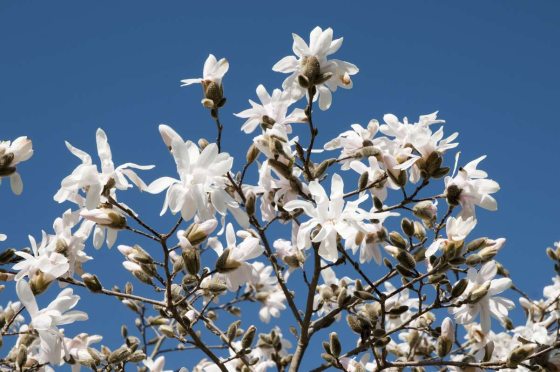
Magnolia stellata exhibits remarkable flowers that attract not only pollinators but plenty of admiration from our guests. Photo by Larry Albee.
Princess-trees: Iconic Trees of Longwood Gardens
The flowering of the princess-trees (Paulownia tomentosa) is one of the most anticipated spring events at Longwood Gardens. Provided that winter has not been too cold, the allée of princess-trees will soon transform into a mass of lilac-colored flowers as the temperatures warm. Although we grow them for the flowers, the princess-tree is revered in Japan for its wood. The wood is lightweight, yet extremely durable and used to build numerous Asian origin instruments and furniture. Despite its beauty and usefulness, Paulownia is considered to be an invasive species in much of the southeastern US and further planting and horticultural uses should be discouraged.
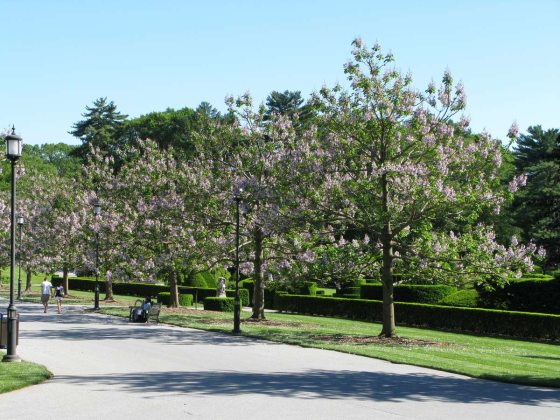
The lovely lilac hues of our Paulownia tomentosa play off the verdant Topiary Garden, nestled behind them. Photo by Eva Monheim.
Trilliums: Charismatic Native Plants of the Forest
Trilliums are among the most recognizable group of plants native to the eastern United States. In fact, there are more species of trillium in the southeastern US than anywhere in the world. Trillium luteum can be found flowering in Peirce’s Woods in April and May and is immediately recognizable for its distinctive yellow flowers (which smell like lemons) and intricately mottled foliage. This type of foliage pattern is not exclusive to trilliums; many woodland plants, from the US and around the world, exhibit similar foliage mottling. While there is a debate, the general consensus is that the mottling provides camouflage from herbivores while intensively silver spots are meant to attract pollinators.
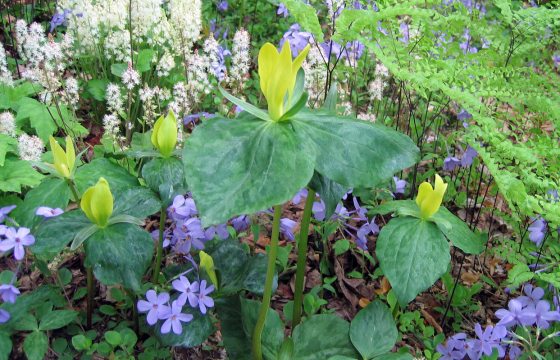
Trillium luteum in Peirce’s Woods provide not only a pleasant sight, but a pleasant citrus-like smell. Photo by Jeanne Frett.
Camellias: Northern Limits
Camellias are well-known landscape plants common in gardens of the southeastern US. However, there are some selections that have been specially selected for adaptation to the colder climate of southeastern Pennsylvania. In fact, camellias have been bred for cold hardiness at Longwood Gardens since the late 1950s. The program reached its zenith in 1984 when plant explorers traveled to remote islands off the coast of Korea to locate the northernmost, and likely most cold-hardy, populations of the well-known Camellia japonica.
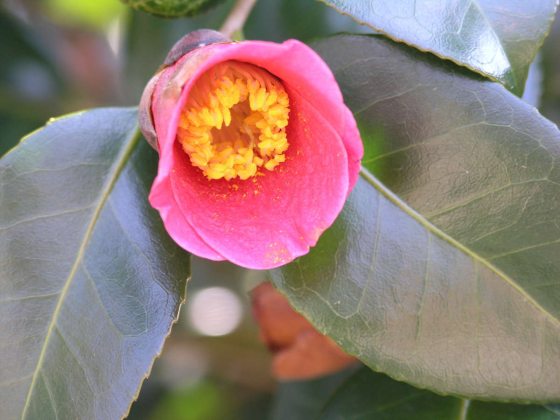
A close view of Camellia japonica. Photo by Tomasz Anisko.
They successfully located that plant, collected seeds, and sent them back to the US. After decades of trialing them, they have proved to be among the most cold-hardy of all camellias, and two cultivars, ‘Longwood Centennial’ and ‘Longwood Valentine’, were selected for their hardiness, form, and red flowers. Both of these hybrids can be seen near the Chimes Tower in our Hillside Garden.
From early winter-aconite and snowdrops to our vivid camellias, come see these beauties for yourself during our colorful Spring Blooms season.
